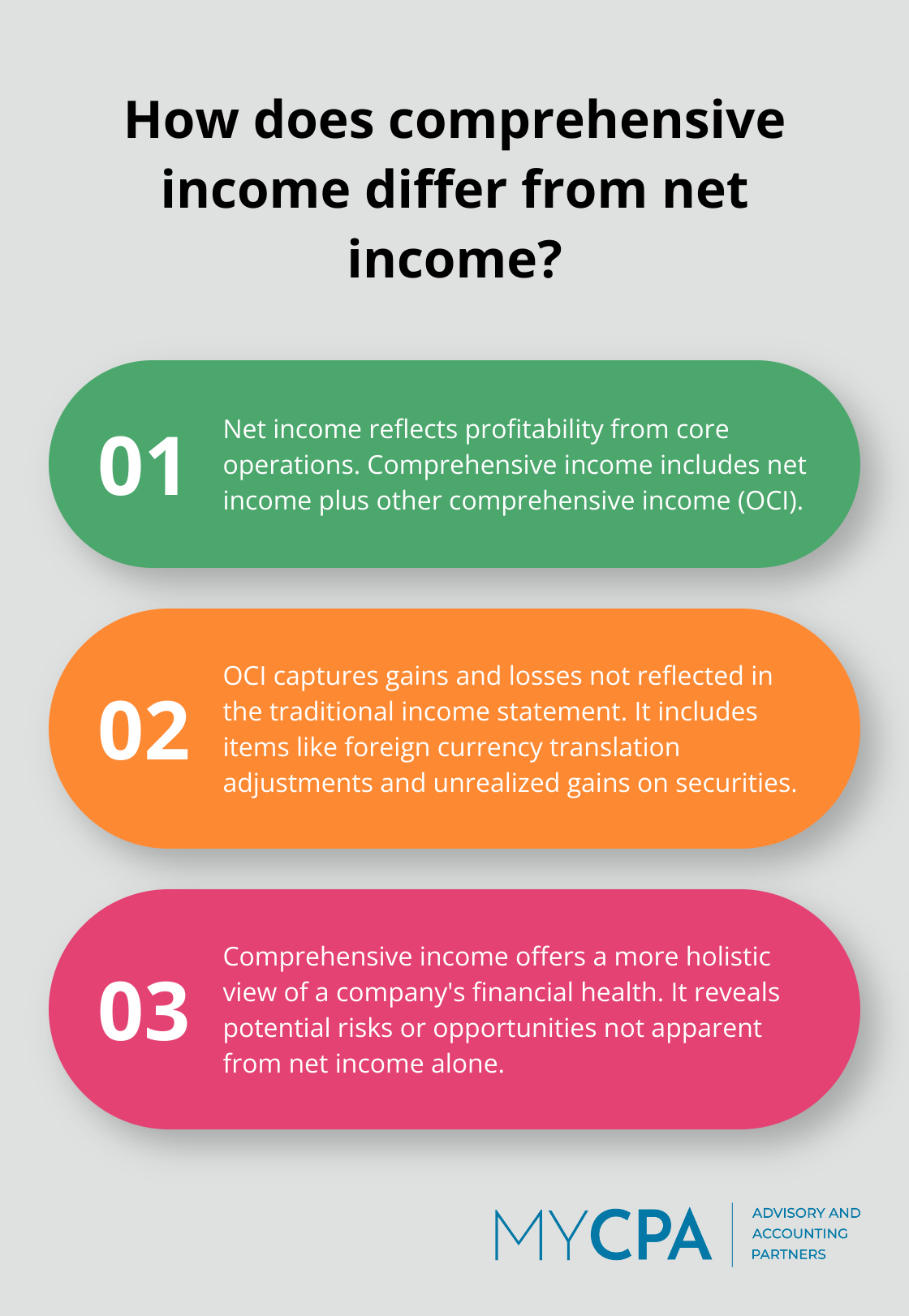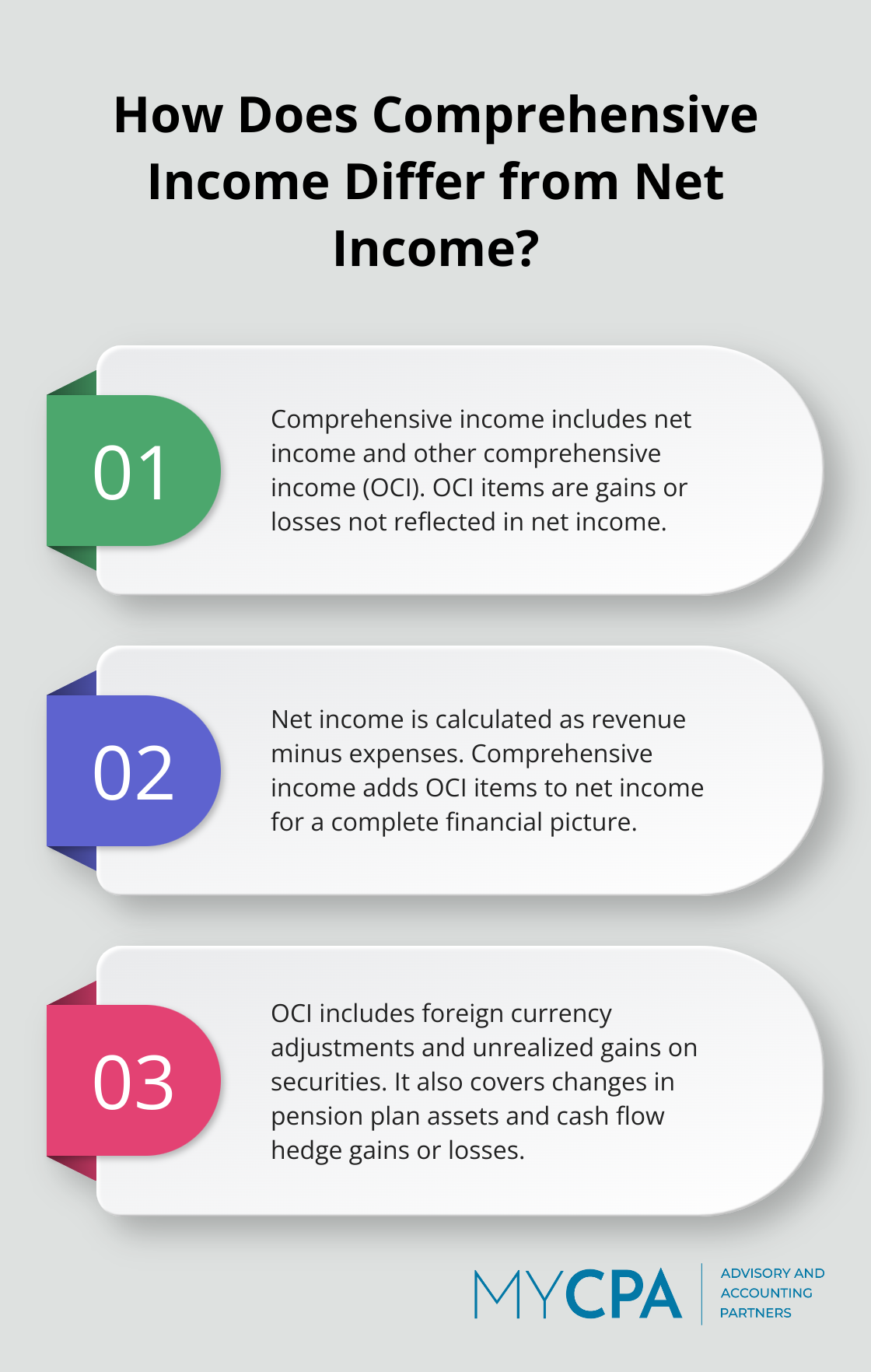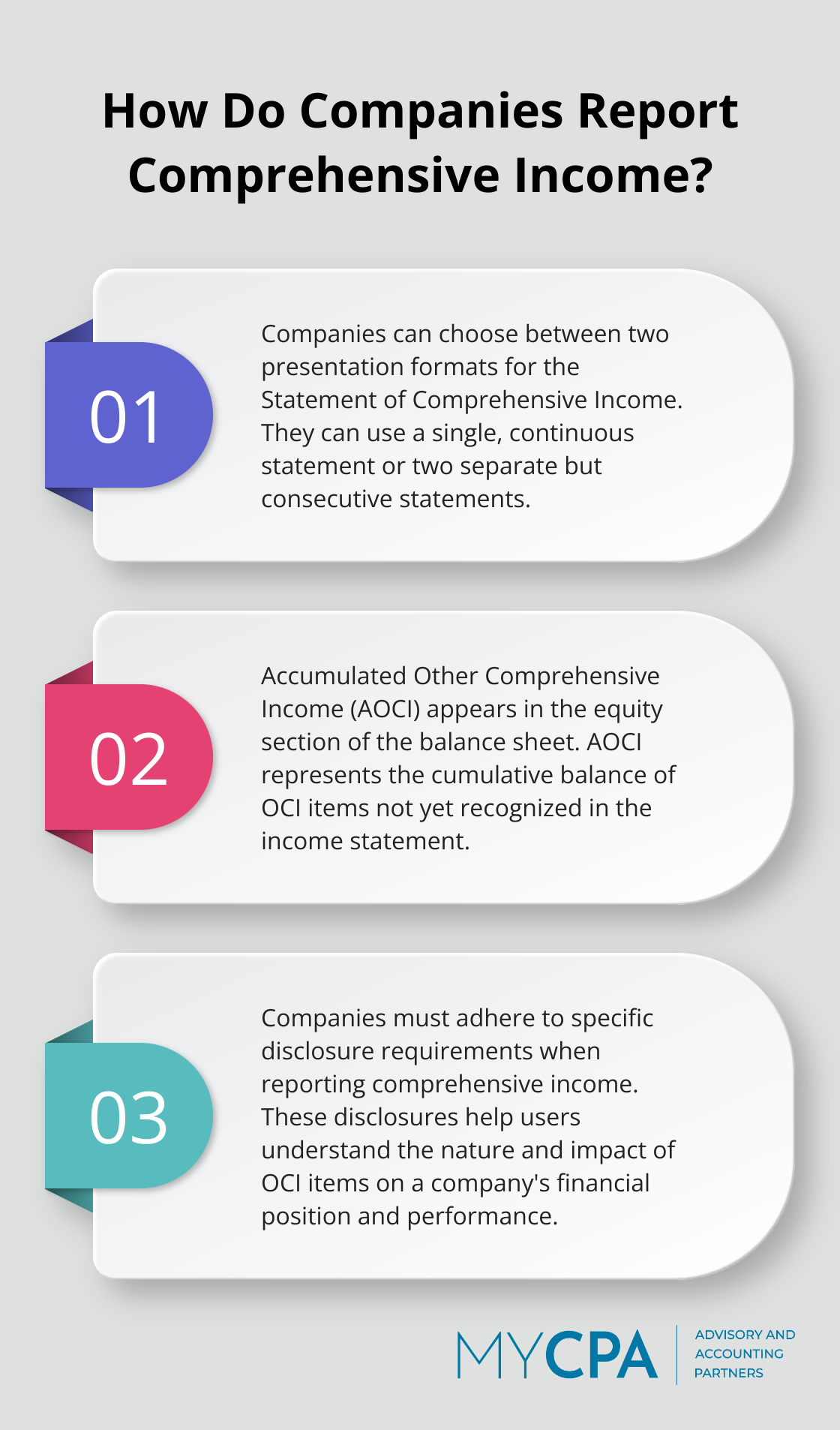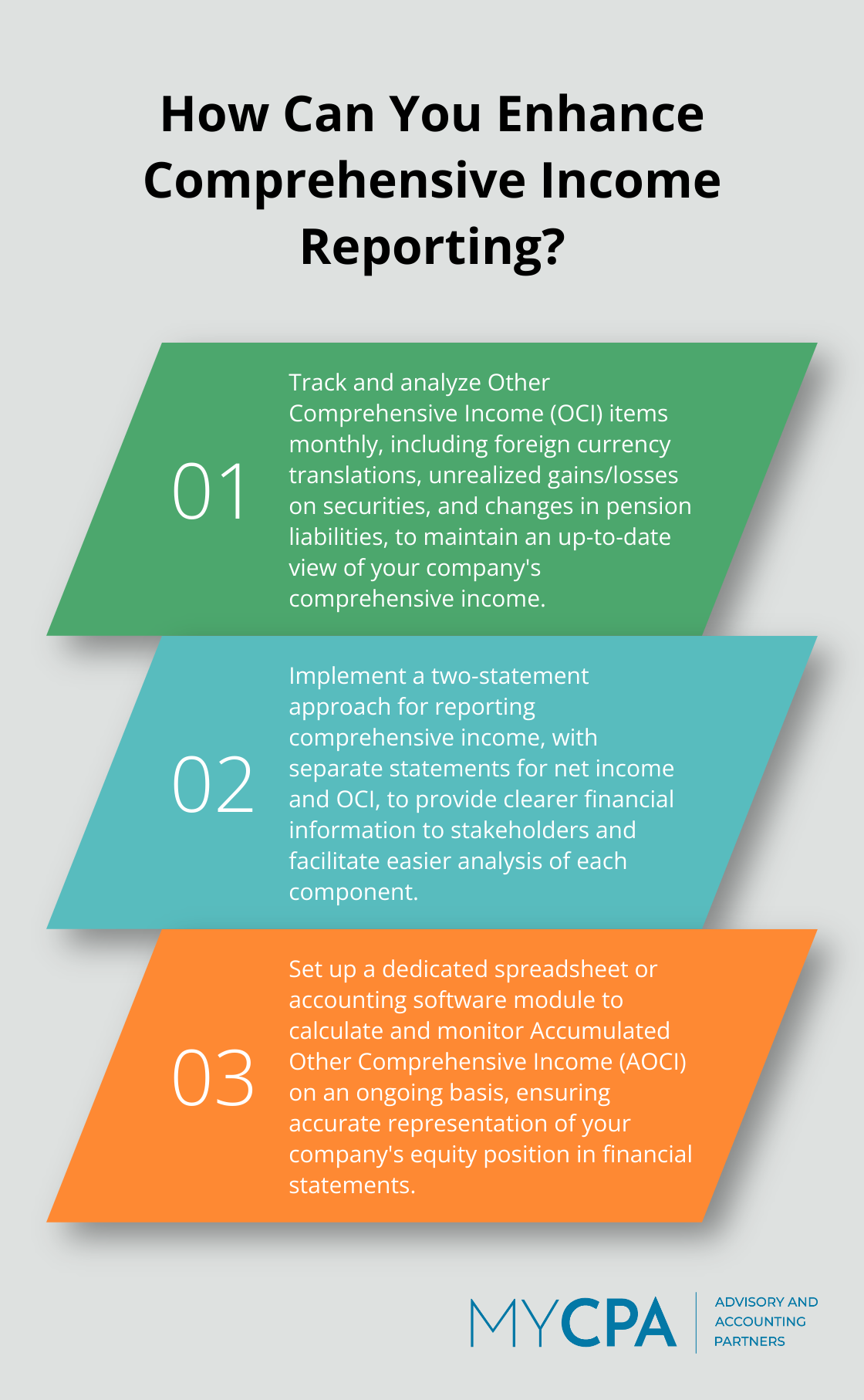
At My CPA Advisory and Accounting Partners, we often encounter questions about comprehensive income in accounting. This crucial financial metric goes beyond traditional net income, providing a more complete picture of a company’s financial performance.
Understanding what comprehensive income is in accounting and how to calculate it accurately is essential for financial reporting and analysis. In this post, we’ll break down the components of comprehensive income and guide you through the calculation process step by step.
Comprehensive income provides a broader measure of a company’s financial performance than net income alone. This concept is essential for a more complete financial picture.
Net income, the bottom line on the income statement, reflects a company’s profitability from its core operations. Comprehensive income expands on this by including net income plus other comprehensive income (OCI), which captures gains and losses not reflected in the traditional income statement.
OCI typically includes items such as:

These items can significantly impact a company’s financial position but often remain overlooked when focusing solely on net income.
Understanding comprehensive income is important for several reasons:
For example, a company might report strong net income but have significant unrealized losses in its investment portfolio. Comprehensive income would capture these losses, giving a more accurate picture of the company’s overall financial position.
For business owners and financial professionals, recognizing the importance of comprehensive income leads to better financial decision-making. It’s not just about the bottom line; it’s about understanding all the factors that can impact a company’s financial health.
A comprehensive approach (which includes analyzing both net income and comprehensive income) ensures that no significant financial impacts are overlooked in the decision-making process. This approach provides a more accurate assessment of a company’s financial performance and position.
Now that we understand what comprehensive income is and why it matters, let’s explore how to calculate it accurately.
Calculating comprehensive income provides a complete picture of a company’s financial performance. This process involves more than just determining net income; it requires the identification and quantification of other comprehensive income (OCI) items.
The formula for comprehensive income is straightforward:
Comprehensive Income = Net Income + Other Comprehensive Income (OCI)
While the formula appears simple, the challenge lies in accurately identifying and quantifying OCI items.
The first step in calculating comprehensive income involves identifying all relevant OCI items. These are typically gains or losses that don’t appear in net income but still affect a company’s overall financial position. Common OCI items include:

A thorough review of all financial transactions and events ensures no OCI items are overlooked.
After identifying OCI items, the next step involves quantifying them. This process often requires specialized knowledge and may involve complex calculations. For example:
Foreign currency translation adjustments require converting financial statements of foreign subsidiaries into the reporting currency.
Unrealized gains or losses on available-for-sale securities involve determining the fair value of these securities at the reporting date and comparing it to their original cost or previous reported value.
Once all OCI items are quantified, sum them up to get the total OCI. Add this figure to the company’s net income to arrive at comprehensive income.
For instance, if a company has a net income of $1,000,000 and OCI items totaling $200,000, the comprehensive income would be $1,200,000.
It’s important to note that comprehensive income can be negative if OCI losses exceed net income or if there’s a net loss for the period.
Accurate calculation of comprehensive income ensures compliance with accounting standards and provides stakeholders with a complete view of a company’s financial performance. This comprehensive approach to financial reporting allows for better-informed decision-making and a more accurate assessment of a company’s overall financial health.
The next step in understanding comprehensive income involves exploring how companies report this financial metric and the specific disclosure requirements they must follow.
The Statement of Comprehensive Income serves as the primary tool for reporting comprehensive income. Companies can choose between two presentation formats:

The choice often depends on the complexity of a company’s OCI items and stakeholder preferences. Companies with significant OCI items typically prefer the two-statement approach for clarity.
Accumulated Other Comprehensive Income (AOCI) represents the cumulative balance of OCI items not yet recognized in the income statement. This figure appears in the equity section of the balance sheet.
Careful tracking of AOCI is essential, as changes in this balance can significantly impact a company’s financial position. For example, a company with large unrealized losses in its investment portfolio might have a substantial negative AOCI balance, potentially affecting its overall equity position.
Companies must adhere to specific disclosure requirements when reporting comprehensive income. These requirements are essential for providing a clear understanding of a company’s financial position and performance.
These disclosures help users of financial statements understand the nature and impact of OCI items on a company’s financial position and performance.
Proper reporting of comprehensive income extends beyond compliance; it provides a clear, accurate picture of a company’s financial health. Meticulous adherence to these reporting guidelines enhances transparency and builds trust with stakeholders.
At MyCPA Advisory and Accounting Partners, we emphasize the importance of accurate comprehensive income reporting as part of our tailored financial services. Our expertise in tax services, accounting, and business advisory ensures that our clients’ financial statements (including comprehensive income reporting) meet the highest standards of accuracy and compliance.
Comprehensive income provides a more complete picture of a company’s financial health than net income alone. It includes both realized and unrealized gains and losses, which offers stakeholders a broader understanding of an organization’s overall financial position. This holistic approach proves essential for making informed decisions and accurately assessing a company’s performance.

Accurate calculation of comprehensive income requires attention to detail and a thorough understanding of accounting principles. Companies must track foreign currency translations, changes in pension liabilities, and fluctuations in the value of available-for-sale securities to maintain precise reporting. Analysts and investors rely on this metric to gain deeper insights into a company’s financial stability and potential risks.
Understanding what comprehensive income is in accounting is important for businesses of all sizes. At MyCPA Advisory and Accounting Partners, we recognize the significance of comprehensive income in providing a clear financial picture. Our team of experts helps businesses navigate the complexities of financial reporting, ensuring compliance with accounting standards. We strive to deliver valuable insights for informed decision-making, positioning your business for long-term financial success.








Privacy Policy | Terms & Conditions | Powered by Cajabra